David Mazzucchelli’s formal innovations in Asterios Polyp are almost sixty years old.
The image above shows two 1953 “Pogo” newspaper comic strips by Walt Kelly (as published in Pogo, volume 10 – Fantagraphics Books). Sarcophagus Macabre, the vulture, “talks” in courier font (June 10) while the Deacon Mushrat speaks in Gothic Blackletter (June 11). Plus: Sarcophagus’ speech balloons have the format of a condolence envelope. You can read a brief, but interesting essay about politics in Pogo, here.
As we can see above David Mazzucchelli also used different speech balloons’ formats and fonts as characterization (see also Derik’s post).
Sarcophagus Macabre’s name, species, and ascribed balloon format are enough to know what he is, but the courier font needs an explanation: he’s an hypocrite because he expresses condolences sending form letters written with a (cold, of course) machine. The Deacon talks in Gothic fonts because he’s a cleric (he reads the Bible and he’s a conservative, not because he’s a Christian, but because he’s defined by Middle Age writing).
In Mazzucchelli’s case Asterios’ mother “talks” in D’Nealian cursive script (an anachronism) indicating candor and childishness while the father talks in pseudo Greek fonts. He was indeed Greek, but since ancient Greece is known, among other things, for its Mathematicians and Philosophers, the fonts also connote a rational man. Notice also the wavy line that defines the mother’s speech balloon and the father’s rectangle (with no edges; he’s a mild-mannered man).
Saul Steinberg drew the two couples above (as published in The Passport, 1954). Do we start to see a pattern… and a problem? Men are “square,” rational beings, women are vague, intuitive, entities.
As we can see above (in a panel from Asterios Polyp), adding magenta (hot) for Hana and cyan (cold) for Asterios it’s the same view of men and women, the same stereotyping… Ooops! I used the “s” word!…
In a famous essay art historian E. H. Gombrich mentioned “wit” to describe Saul Steinberg’s drawings. Here’s what he said:
In many of his drawings it is the line of the graphic medium which seems ‘an echo to the sense’. His ‘Family’ […] shows us the father firmly modelled, the mother with undulating lines, the grandmother all but fading away between hesitant pen strokes, and, of course, the child drawn in the style of children’s scribbles.
From here it is but one step to the representation of what are called our synaesthetic reactions, the depiction of one sense modality by another.
The ekphrasis sounds familiar by now… The synaesthesia I frankly don’t see (it lacks that “one step,” I suppose). I will not deny the wit and creativity of Saul Steinberg’s visual solutions (some would say visual writing), but drawing attention (pun intended) to just a singular personality trait is a simplification. It has great applications in political satire, no doubt, but it’s not so great a device in a serious (graphic) novel.
David Mazzucchelli agrees with me (or, his character does, as seen above), but he risked the blunt approach nonetheless as seen below (with a pint of self-irony: comic books, really?!)…
Comics are sequences, so, David Mazzucchelli could explore Saul Steinberg’s ideas in a more complex way: showing mood transformations, for instance (see below).
Hana goes from undefined (painterly, as Heinrich Wölfflin put it) to defined (linear; ditto). Wölfflin’s opposition (inspired by Friedrich Nietzsche’s Apollonian-Dionysian dichotomy) was one of Asterios’ favorite aesthetic theories; the other two being essentialism and Louis Sullivan’s famous diktat “form follows function.” She goes from magenta (irrational, life) to cyan (rational, thinking).
The procedure is welcomed, but were the googly eyes and the Utamaro mouth really necessary?…
If you read ’til here you must be saying by now that I hate Asterios Polyp. Well, I don’t, I like the tour de force, but I must plead guilty of double standard. I’m not the only guilty one though: many critics forgive a cliché and a stereotype (calling it “an archetype”) in adolescent and YA genre comics while vigorously attacking the same flaws in art comics. I did the opposite and I still think that Asterios Polyp is one of the best comics published in 2009. I’m sure that I’m misguided though because I failed to read all those marvels published by the big two…
____________
Update by Noah: The entire Asterios Polyp roundtable is here.
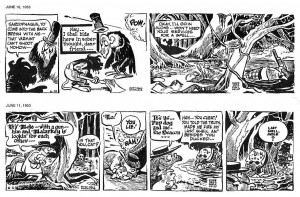
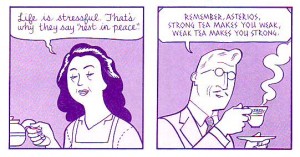
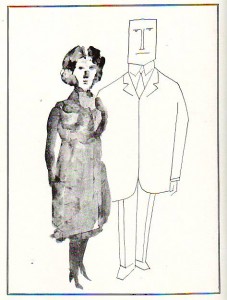


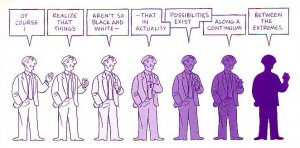

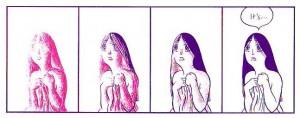
So, because Kelly and Steinberg pioneered these techniques AP loses its legitimacy? Is it wrong to extend the works of innovators?
Then again, I’m probably assuming bad faith where unwarranted, in which case, Domingos, acceptez toutes mes excuses les plus sinceres.
It never occurred to me to see the different speech bubbles for different characters as an innovation…did people really say it was? What seems unique about the book’s formal methods is how systematically they’re applied (which isn’t necessarily a strength in every respect, I don’t think) and the lovely way Mazzucchelli incorporates different styles and ideas into consistently pleasing designs.
I think you raise interesting points at the end about the differences between genre and art comics. I’d argue that AP’s stereotyping is a good bit worse than what you find in good genre work; the characters are poorly defined in comparison to Born Again, for example.
I agree that people approach some art comics and genre work differently…though I think this is a function of what the work presents itself as delivering. You could sum it up by saying that genre work has fewer pretensions. You don’t have to give it a break for that reason if you don’t want to, obviously — but I think when people do, it’s not necessarily because they’re being inconsistent, or lowering standards in quite the way you seem to be suggesting.
I know you’re largely (though not entirely) immune to the pleasures of genre, Domingos — and I feel like I have a better sense of why now. Which I appreciate.
I totally forgot about Pogo! (Probably because I have no copies to read… whatever happened to that new Fantagraphics promised reprints?)
Well, one of those big-two we “love” so much re-released, in 2009, “Watchmen”, a book that also makes use of typesets for some of its characters, and even different shapes and lines on its speech balloons. Is it a better or worse book because of that? Does it really matter?
Should we try to find out who created something first, and then point it out every time someone else uses it? It’s educational, but in an obnoxious way.
Alex: as Noah pointed out above David Mazzucchelli integrated those 60 year old inventions in _Asterios Polyp_ beautifully. It’s not because they’re not exactly new that _Asterios Polyp_ loses legitimacy. My first phrase was just a rhetorical gimmick to catch the readers’ attention.
My real intentions were to question the devices themselves, Kelly’s and Steinberg’s status among the comics literati notwithstanding (you know me: “alone against the sacred cows’ herd” is my motto).
Noah: please read above; I didn’t answer to anyone in particular. It was just a rhetorical statement.
As for peoples’ reactions to genre we’ll have to agree to disagree, but, all this needs some clarification. Genre is viewed today as a social phenomenon instead of being determined by any format (formula). (If it is, it’s _Asterios Polyp_’s formula, as Craig so brilliantly demontrated; Propp saw it eons ago). _The Man Who Shot Liberty Valance_ is one of my favorite films. It’s also a Western.
Thinking that genre is formulaic leads to the famous “it transcended its genre” type of critical commentary (or: “x film is like a comic book:” if it is simplistic, Manichean, and formulaic, precisely). It’s that kind of reasoning that led to Lawrence L. Langer’s infamous statement on _Maus_ not being a comic.
Daniel: yup, I was a bit sarcastic at the end, sorry about that: could you see my blurry magenta lines?
I didn’t say that the issue with genre was that it was formulaic. I said that it is less pretentious. I think there’s a difference.
At the same time…I think reducing genre entirely to a social phenomena rather than looking to formal aspects as well ends up missing something.
I also, just in general, don’t think formulas are bad necessarily. It depends on how they’re used. I’m a big fan of the Friday the 13th films, in part because there’s something lovely in the endless repetition of tropes, with slight variations, within and between films.
I think there’s something to the idea that certain works transcend genre (or use genre to get somewhere else.) Those aren’t always the best works though, necessarily. Nachtmystium is trying hard to be black metal going somewhere different, and I like them, but Funeral Mist, which is black metal first last and always, is really more creative and in general better. It just depends.
Anyway, we can all agree that the Man Who Shot Liberty Valance is great, I think….
Noah: I was just answering to this: “I know you’re largely (though not entirely) immune to the pleasures of genre, Domingos[.]”
You raise interesting questions about formula and genre. As Derrida put it (and Propp before him): “there is no genreless text…” As for formula, maybe you’re right. It’s just *this* formula that I don’t like: there’s a disruption of a certain order (usually linked with the powers that be) by uncontrollable forces, there’s a vapid hero (with a few stock characters, some for comical relief) who tries to reconstitute said order; he fails miserably, he has an epiphany, he wins. The end. I say “he” because all this is usually very male-centric, but Romantic comedies aren’t really that different (stock characters: the best friend, the gay friend, etc… disruption: the boy in the “boy meets girl” formula does something unspeakably wrong, etc…).
If you say that, even something as stupid as the above can be great in the hands of a genius, I’ll answer that you’re right. After _Zero de conduite_’s fiasco the producer Jacques-Louis Nounez gave Jean Vigo an innocuous (formulaic?) script and he did _L’Atalante_.
But would Jean Vigo be free to do as he pleased today? Even back then, the film was butchered before exhibition.
Do you see what I mean: at this level of stupidity genre is a social and economical construct?
I think that genre is popular, and therefore there are economic and social incentives to produce (certain) genres. I don’t know that that’s quite the same as saying that genre is a social and economic construct solely.
We’re on pretty much the same page in the evaluation of AP, though, I think.
There are great rom coms; His Gal Friday and Bringing Up Baby being maybe the most obvious examples. It’s a (movie) genre that’s fallen on hard times as far as creativity goes, though.
I did quote Derrida (“there is no genreless text,” etc…). The second part of my answer above dealt more with formula (and a specific formula, at that) than genre.
Those old comedies didn’t rely as much on the “I’m a jerk, please forgive me!” formula. Maybe _It Happened One Night_ is the exception.
“Those old comedies didn’t rely as much on the “I’m a jerk, please forgive me!” formula.”
That’s a brilliant observation. I’ve sometimes wondered what happened to romantic comedies as a genre, and the “I’m a jerk, please forgive me!” meme is probably as good an answer as I’m going to get. I really hate that — basically because, as in AP, you almost always feel like it’s not actually a happy ending, despite the story’s best efforts to convince you otherwise. The happy ending would be for the woman to go find someone who is not a jerk.
Usually, the writing’s crappy and the chemistry’s not there–so you never end up feeling that the couple are actually “in love”– Montages of people talking and laughing doesn’t substitute for actual dialogue wherein you get the sense people have similar senses of humor, “connect,” or whatever. Most rom coms touch the bases of the genre without actually giving you the meat of a relationship that you’d actually believe.
I still think “When Harry Met Sally” is probably the last “great” rom com. I’m sure someone will hoot this down…but it really is great. So many copied it feebly (often with Tom Hanks for inexplicable reasons) in the immediate and long term aftermath, but with little success.
Harry is kind of a jerk (in the model above)—but there is an extended portion of the film where Harry and Sally are “friends,” wherein they actually have conversations that are humorous and revealing, etc…So, when Harry treats Sally badly, you already have some goodwill built in for him. Billy Crystal’s not really a very good actor, but the writing is good enough to make it work. Hanks is a better actor, probably…but films like “Sleepless in Seattle” give you the rom com “formula” without any actual details to make you forget for a minute that it really is just formula.
I am pausing to savor for a moment that we’re discussing middling 80s romantic comedies in a post by Domingos.
Ok, savoring complete. And yes, I’ll hoot down Harry Met Sally. Though I’ll admit it looks relatively good compared to something like Sleepless in Seattle. Or Yes Man.
I’ll vote for Say Anything though. It completely avoids (as Harry Met Sally does not, I don’t think) the dynamic where the guy is a jerk and you’re/she’s supposed to forgive him.
I cannot express to you how tedious it is that all the romantic heroes are either jerks we’re supposed to forgive, losers we’re supposed to encourage, or squares we’re supposed to tolerate. How ‘come there’s not a well-adjusted sexy-smart cartoonist in the bunch?
Domingos! You’re not giving Saul Steinberg enough credit — those stereotypes in 1954 were so dominant in the culture, so accepted, that making them the point of a drawing like that is mostly just shining a light on them. They work differently when Mazzucchelli shows them, since we’re hyper-aware of them now…of course, they could just be somewhat anachronistic, like the Maoist kid…
Very interesting post on AP, but quickly back to the rom com discussion: I can’t believe you guys haven’t mentioned Amelie as an example of a great modern rom com.
I soooo hated Amelie. It was just too cloyingly sweet and “quirky”.
Thinking about a lot of those classic rom-coms… Many of them seem to revolve not on the “guy as jerk” but on the “stubborn woman” motif. Where the woman didn’t want a man or a relationship, and the guy is the persistent suitor… who teaches the woman she really does need a man… or maybe I’m extrapolating too much, because I saw half of one last night that fit that model. But… Philadelphia Story fits that… doesn’t His Gal Friday, too…
Caro: I admire Steinberg immensely (he influenced one of my favorite cartoonists: Chago Armada), but are you sure that he was satirizing the stereotype? I don’t think so because he was one of the first cartoonists who didn’t try to be funny. I think that he meant what he drew. To be fair though: in _The Passport_ there’s one couple in which she’s well defined (but not “square”) and he’s unfinished and blurred.
Derik: ditto _Amelie_. The “stubborn woman” motif is the “seduction” motif. They hate each other’s guts at the beginning to fall in love at the end. This trope may also be used between a child and an old man, etc…
In rom coms it works well if the dialogues are smart, the actors are good, and the director is Howard Hawks (kidding!). The latter is just saccharine, I suppose (throw in a big, clumsy, dog with doggy eyes)…
Hi Domingos: Oh, I don’t think Steinberg was satirizing at all — I didn’t mean to imply that. But satire is far from the only way art shines light on things. Any representation is always in conversation with the dynamics of cultural awareness.
The extent to which these characterizations are thought of as “stereotypes” is something that changed substantively between Steinberg and Mazzucchelli. When Steinberg represented gender this way, he was representing something that his culture wasn’t hyper-aware of — they were aware of it, but it was a given for most people, not something to be self-conscious about or question. When Mazzucchelli represents the same thing, it’s not the same thing — because it’s now something that his culture is hyper-aware of and very self-conscious about. That’s what gives me that feeling of anachronism.
(There’s a lot of mid-century aesthetics in AP…I can’t say I’ve figured out what to make of it, though. But I would totally buy Asterios’ parents’ house.)
“When Steinberg represented gender this way, he was representing something that his culture wasn’t hyper-aware of — they were aware of it, but it was a given for most people, not something to be self-conscious about or question.”
I’m unsure this is true, and I’m not really sure why this lets him off the hook even if it is true. People have been aware of, and talked about, ideas of sexual difference for a really long time. The 50s had no lack of narratives about how women should behave or what women were; Steinberg wasn’t blazing new trails by self-consciously saying, “men are more rational, women are more emotional.”
I’ll admit, sixty years later and post-feminism, Mazzucchelli’s version looks willfully obtuse, while Steinberg’s (maybe) just looks obtuse. But both seem pretty conceptually lazy.
Noah:
I’m not saying the ’50s weren’t aware of gender difference: that would be nonsense. But they didn’t think those stereotypes were BAD. It matters immensely when talking about the 1950s to recognize how much more people valued and accepted constructs defining what was “normal.” Steinberg’s drawings were speaking to a culture that valued conformity much more than we do today, and that drew the line between stereotype and “role model” very differently than we do today.
I’m not really trying to make a point about Steinberg, though, based on these drawings: I don’t own a copy of The Passport and I’m not sure which episode these come from. Taking them out of context doesn’t get us very far. Domingos, do these images come from the series of drawings where Steinberg is tracking the trajectories of the lives of the man and the woman through stages like infancy, childhood, young adulthood, middle age, etc?
In that series, Steinberg critiques conformity in masculine culture using the relative sartorial “freedom” of the woman as his point of contrast. Not particularly feminist, but not exactly obtuse either.
But I can’t imagine Mazzucchelli — anybody! — is too obtuse to recognize that this is an anachronistic stereotype. I may, however, be too obtuse to figure out why he’s using it.
Okay, I get it; you’re saying that the images are valuing women for their spontaneity. But that’s exactly what Mazzucchelli is doing! Male rigidity bad, female emotions good.
I think you are only being obtuse insofar as you underestimate obtuseness. This kind of pop gender essentialism continues to have enormous currency; people make millions in selling books, magazines, movies, etc. etc. which essentially simply reiterate these distinctions. I see no particular reason why Mazzucchelli couldn’t buy into them — and, indeed, from his book, there’s a fairly compelling case that he does exactly that. He’s an enormously gifted illustrator and designer, but those skills have little to do with conceptual or theoretical talent.
Thought of a better way to say this, Noah: by hyper-awareness, I mean that sense we have today of “gender identity” as something flexible and theatrical, culturally constructed. Although gender differences were pronounced and rigid in the 1950s, the culture was structured for people to internalize those differences. They knew there were there, but an awful lot of people believed in them without any suspicion.
Steinberg doesn’t pose any kind of significant challenge to the normal/pathological dynamic, and he didn’t pay much attention to gender itself as a social problem, but his emphasis on body image — what Wilhelm Reich calls “character armour” — definitely made people at the time more aware of the artificiality of their social identity. I consider his critique of social conformity to be a very valuable predecessor to the social upheaval of the next decade. That’s why I felt like Domingos wasn’t quite giving him enough credit — although I’m sure he was just using them to point out the comparison with Mazzucchelli: Steinberg’s drawings do instantiate the stereotypes, but there’s a whole lotta other stuff going on.
Caro: these drawings come from a series of 11 couples. There’s also two groups of 3 people and the family as described by Gombrich above. The series that you cite also uses the “line expression = character’s personality” technique. Another series of 3 drawings expands it to parties: 9 characters; 14 characters; and the tour de force: 33 characters (if I counted correctly). Mazzucchelli also cites the latter in _Asterios Polyp_.
No, no, I don’t think that Steinberg is “valuing” women for any particular reason, or men either for that matter: I think he’s making a point about conformity by playing the arche/stereotypes off each other. What’s important though is that he’s not making a point about “artificiality.”
Steinberg wasn’t that meta: he was still earnestly busting up the idea of conformity itself, not the ways it’s naturalized. That does “let him off the hook” a little bit: being pre-feminist doesn’t make him anti-feminist!
These drawings are important historically because they are indeed a first stab at the idea that gender performance is artificial — but he just wasn’t there yet, so the stereotypical identities are still in play.
But why is Mazzucchelli using them the same way? Has anybody figured this out yet? I’m leaning toward agreeing with you that he buys into them, but…man, that’s just kind of SAD.
Thanks, Domingos. This reminds me how much I want to suck up the $100.00 and buy a copy of The Passport. :)
Caro: I titled my contribution to this discussion “Smart Cardboard?” “Smart” because Steinberg’s ideas are very creative and draw attention to how expressive and flexible a line can be. His drawings rival writing (that’s why I cited the _Visual Writing_ exhibition).
“Cardboard?” because I don’t believe in the stylus virum arguit dictum. Reducing his characters to a simple personality trait is poor characterization. That was my whole point.
I understand what you are saying though: good artists catch their times like an antenna catches waves. And Steinberg certainly was a great artist. Hence the question mark (meaning: am I really sure of what I’m saying?). Some sacred cows are so big and inflated that they are excellent targets. Lets just say that Saul Steinberg is not one of them and leave it at that…
As for Walt Kelly: he did political satire. He was supposed to be blunt.
“I mean that sense we have today of “gender identity” as something flexible and theatrical, culturally constructed.”
Who is this “we”? The vast majority of people still believe gender identity is real. Some grad students who have read Judith Butler don’t…but that’s hardly a cultural consensus.
” Although gender differences were pronounced and rigid in the 1950s, the culture was structured for people to internalize those differences. They knew there were there, but an awful lot of people believed in them without any suspicion.”
Possibly I don’t know enough about Steinberg, but I don’t see anything in those drawings that suggests the gender identity is theatrical. I mean, if you were talking about Beardsley (who was around 50 years earlier), I’d buy it.
I guess I just don’t see how reiterating the stereotypes is questioning or undermining the stereotypes in this instance. That does sometimes happen — as with D.H. Lawrence perhaps. But Lawrence was several decades earlier than Steinberg, yes? And he was hyperaware of masculinity and femininity as contested tropes. That’s kind of all he wrote about.
Lady Gaga has sold over 15 million albums and 40 million singles. That (to pick a random example from the large bank of gender theater provided by our current popular culture) does not indicate that the vast majority of people are “unaware” of any ideas about gender performance. That vast majority might not be able to articulate it, and they might not like it, but they are aware of it.
You’re basically saying that the women’s movement didn’t change the perspective of our culture at all. That’s bullshit.
It’s not that you don’t know enough about Steinberg; it’s that you’re looking at a detail of a work and missing some of what it accomplishes. I’m not saying they’re not stereotypes. I’m saying that those stereotypes made different cultural sense — and had a different cultural impact — in 1954 than they do now.
I know you’re not seeing my point, but try this: He’s not “reiterating” them: he’s “iterating” them. Not for the first time, but more starkly than they were usually iterated in the period when he was drawing. He’s not “questioning” them or “undermining” them: he’s “deploying” them — not uncritically, but for a purpose that isn’t (yet) about questioning the stereotypes but questioning the society that created them. Not meta, but not obtuse.
DH Lawrence, Virginia Woolf, Oscar Wilde — in bohemia, you can find lots of instances of gender performance in the modern sense. Just like you can find its origins among the aristocracy in the 17th century, and in the theatrical culture of the 16th. But in bourgeois culture it was much less common, and in bourgeois culture in the 1950s it was scandalous. But Steinberg — accessible, powerful, graceful, and popular — pointed out to the bourgeoisie that their “character armor” was a performances too.
Don’t diminish how important that was for setting the stage for the cultural upheavals of the next 20 years. All I’m saying is that it is worth noticing how it meant something different when Steinberg did it in 1954 than it does when Mazzucchelli does it in 2009.
I also think it’s important historically that Steinberg didn’t cast these drawings as about “gender” per se: that made them much more impactful to a bourgeois audience that wasn’t ready yet to hear Gloria Steinem or buy a David Bowie album.
And I’m of course being provocative when I say that you’re saying the women’s movement didn’t change our culture at all ’cause I know you don’t think that. But you’re not asking yourself what is gained by ignoring the fact that Steinberg himself hadn’t and wasn’t working in a culture that had already experienced that cultural cataclysm and had the benefit of the insights it produced…or what it means that Mazzucchelli also ignores that fact, vice versa.
Lady Gaga is bohemian, in much the way that Virginia Woolf and Wilde and Lawrence and Beardsley were. They were all, in their ways, celebrities as well. I’m not sure why the popularity of the bohemian gender-bender now is admissable and the popularity of the bohemian gender-benders of the past are not.
Which is to say, yes the women’s movement changed things, sure. I don’t think it changed things as much as you’re claiming it changed them, necessarily…and I think it had in fact already done some changing by the period we’re discussing.
I don’t see Steinberg making a claim about performance. If anything, it seems like he’s being semi-expressionist — using line to show what people really are, not what they’re pretending to be.
It’s not even clear to me that gender-as-performance is necessarily all that liberating, or that that particular meme was all that important for the coming cultural upheavals. Certainly, though, it seems weird to point to Steinberg as their cause or even ground when his interest in them seems tangential and, as you say, those particular ideas had a fair amount of currency among canonical authors long before the 1950s.
Also…you know, even if David Bowie wasn’t around, Elvis was a fairly bizarrely androgynous figure for his time…. Not to mention Little Richard. Pop culture queerness hardly began with the British invasion.
Hey, more in a few hours: dont want to respond from my phone. Thumb-typing is even worse than stereotyping…
You should probably just stop there. Don’t know what argument you’re going to come up with that’s more devastating than that pun….
On the subject of Saul Steinberg, you folks may remember this from when it happened but I just came across this video and story about a 22-foot Steinberg mural, drawn for the SS Excambion luxury liner. It was discovered and rescued just before the ship was sunk to become part of an artificial reef.
http://www.chron.com/disp/story.mpl/metropolitan/5198168.html
http://www.tpwd.state.tx.us/newsmedia/videos/vnr/clipper_art.phtml
Does anybody know if it ever got put on display anywhere? The article says it’s in storage in Austin but I can’t find any updates…